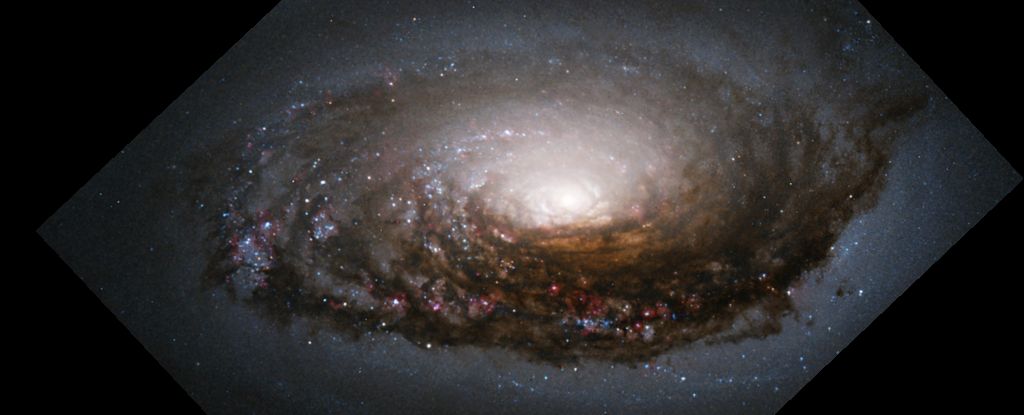It doesn’t take a huge leap of imagination to see why M64 is better known as the Evil Eye galaxy. Sitting in the abyssal vacuum of space it seems to cast a sinister glare across the cosmos, a cloud of dust framing its visible periphery like a dark bruise.
The galaxy is even stranger than it looks. Its hydrogen-rich outer disk orbits in the opposite direction to the galaxy’s inner disk of stars, hinting at differences in their origins.
Now, astronomers have worked out the outer disk’s hydrogen gas came from a smaller, gas-rich satellite dwarf galaxy, one M64 recently cannibalized and wrapped itself in. It’s that smaller galaxy’s material that is darkening M64’s outskirts.

The discovery could be giving us a glimpse into the future of our own Milky Way galaxy. Estimates of the mass and contents of the shredded satellite suggest that it was remarkably similar to the Small Magellanic Cloud, a Milky Way satellite dwarf galaxy that will one day be subsumed into the larger mass.
These findings, led by astronomer Adam Smercina of the University of Washington, have been accepted into The Astrophysical Journal Letters, and are available on preprint server arXiv.
“We find evidence for a spectacular shell feature, and other tidal structures indicative of an ongoing, late-stage radial merger,” the researchers write.
“We estimate the stellar mass of the progenitor galaxy to be 500 million solar masses, with a metallicity of [M/H] ≃ −1 – very similar to the mass and metallicity of the Small Magellanic Cloud.
“The mass of M64’s counter-rotating outer gas disk is also comparable to the gas mass of the Small Magellanic Cloud, suggesting that the likeliest origin of M64’s unique counter-rotating disk was a recent merger with a gas-rich satellite very similar to the Small Magellanic Cloud.”
Galaxy mergers are thought to be a very important part of galaxy growth and evolution. These events not only increase the mass of a galaxy, they infuse it with new material and gravitational interactions that increase star formation, keeping the galaxy alive with new generations of stars.
The Milky Way has merged with other galaxies multiple times over its long, 13.6 billion-year history, and we can see other galaxies in the Universe at various stages of the merger process.
Because galactic cannibalism isn’t uncommon, it seemed reasonable to think that the odd gas on the fringes of M64 was the result of one of these events.
Previous studies, however, found puzzlingly few signs of a recent galaxy-galaxy interaction, leading to the suggestion that the hydrogen disk had been slurped up just from the space around the galaxy, or from a brief, fly-by encounter with another galaxy named Coma P.
Evidence for either of these scenarios was also lacking, however; so Smercina and his colleagues enlisted the Subaru telescope’s Hyper Suprime-Cam to study the space around M64, some 1.4 million light-years away, looking for signs of the outer disk’s origin in lone stars far from the main disk of the galaxy.
Their observations revealed what they say are clear traces of a galactic merger. They found a galactic halo – a diffuse sphere of dark matter, gas, and stars that encapsulates spiral galaxies, which is thought to form and grow through galaxy mergers.

Map of stars around M64, showing shell features to the southwest and northeast. (Smercina et al, arxiv, 2023)
But they also found evidence of a shell. This is a density of stars that is produced through the gravitational interaction between two merging galaxies. As the galaxies orbit each other, their gravitational interaction creates drag that causes stars to be pushed together, a bit like the peaks of ripples in a pond.
Comparison with simulations showed the distribution of the shell around M64 is consistent with what is known as a “minor” merger; that is, the absorption of a satellite dwarf galaxy by the larger host.
The motion of the gas suggests this satellite had a partially retrograde orbit around M64. And the dusty center and dark smudges of dust are the result of the ongoing merger as material collides with M64’s inner disk of gas.
To confirm this scenario, the researchers used data from Hubble to estimate the mass and composition of the absorbed galaxy. They derived a stellar mass of around 500 million solar masses, consistent with the 300 million to a billion solar masses of the Small Magellanic Cloud.

A loose map of M64 halo stars (left) compared to galactic merger simulations (right). (Smercina et al, arXiv, 2023)
The mass of the hydrogen disk around M64 is also around 500 million solar masses, which again, the researchers say, is consistent with the 400 million solar masses worth of gas in the Small Magellanic Cloud. Together, the clues seem to point pretty convincingly at galactic cannibalism, recently enough to have left these traces – within the last billion years.
“The likely origins of the Evil Eye’s counter-rotating gas are at last revealed, after decades of curiosity,” the researchers write.
“We suggest that its outer gas disk was accreted recently during a 52:1 merger with a Small Magellanic Cloud-mass galaxy and is now colliding with an existing inner gas disk, fueling a burst of star formation at the disk–disk interface and driving the visible dust lanes from which it earns its name. Future observational and theoretical studies will help test this idea.”
Meanwhile, M64 can help us understand how stellar halos are formed. Being able to calculate the previous orbital motion of a now-consumed satellite galaxy could help reproduce M64’s halo evolution, providing valuable insight into the growth of these mysterious structures.





